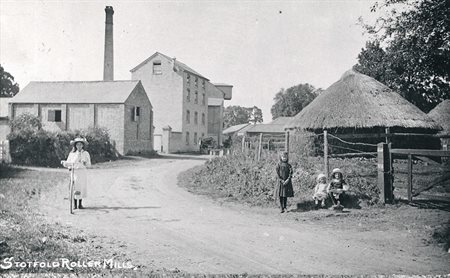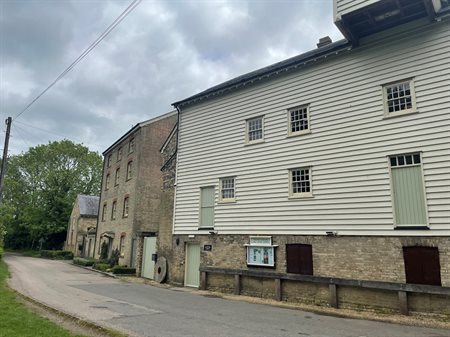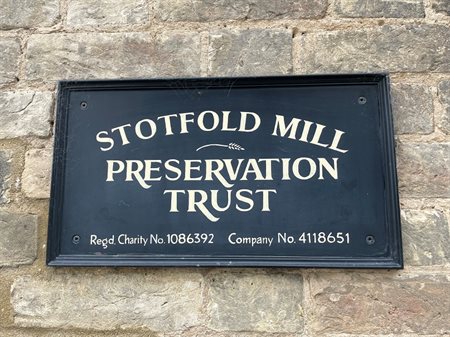Randall's Mill/Stotfold Mill
Information taken from Stotfold Water Mills by Bert Hyde.
Stotfold Mill is the last working watermill in Stotfold. A mill has stood on its location since the Domesday Survey of 1086. Out of the four mills referenced in the Domesday Survey only two were still in Stotfold by 1707 – Randall’s Mill and Taylor’s Mill. Both were referred to as ‘Stotfold Mill’ at various times in its history.
The current working mill was known as Randall’s Mill. The earliest reference to this mill (aside from the Domesday Book) is from 1516 when the mill was referenced as Richard Lorymer’s mill. On 21st Mar 1694 James Sander (or Sanders) surrendered the mill and John Guilber was admitted. By 1770 the mill was owned by Francis Smith, prior to the this the Woodwards and Guilberds had owned the mill for 120 years. When Francis Smith died in 1781 he left the mill to his wife. She continued to run the mill for seven years before it passed to Thomas Gurney and then James Pestell in 1823. In 1825 the mill burned down and the mill had to be rebuilt. By 1869 the Vaughan family had bought the mill and seven years it is taken over by the mills namesake, John Randall.
The Randalls were an old-established Stotfold family and a young John Randall was sent to be trained as a miller at Jordans Mill, near Biggleswade. He eventually took over the mill in 1876, first renting it from Charles Vaughan and subsequently buying it outright upon the owner's death. Randall began making substantial improvements to the Mill, having a steam engine installed for additional power, the 65ft chimney built, and machinery replaced. Renowned Suffolk millwrights Whitmore & Binyon supplied the millwork in the late 1890s, new stones were fitted, and John Lampit of Hemel Hempstead installed an 8ft diameter overshot waterwheel in 1897, replacing the previous undershot one. Fitted with bucket paddles and 14ft wide, it is believed to be the widest corn-mill waterwheel in the UK.

Photo of Stotfold Roller Mills, c.1920 [ref: Z50/115/31]
John Randall also planned to establish a new roller mill alongside the existing mill but died in 1900 and never saw it come to fruition. His son Ebenezer carried on with the project and Redhouse, a prominent local firm, finished the new four-storey brick building in 1902. Based largely on old technology and with fierce competition from much larger mills in the area, the roller mill was not a great commercial success, and quickly fell into disuse. The old mill, however, remained in operation for many years, producing flour and then animal feed. A diesel engine replaced steam power in 1954. Sadly, dwindling economic prospects led to Stotfold's last working watermill ceasing milling operations in 1966. After this date, the buildings were used for storage only, and the last miller, Sam Randall, finally sold the Mill in 1984.

Stotfold Mill, 2024
The mill was given Grade II listing (alongside Mill House and Mill Cottage) in 1974 and was described as an early 19th century mill with late 19th century alterations and additions. It had three storeys with attics, and a fourth storey block on the north main block.
On 15th December 1992 a huge fire destroyed the mill, completely gutting it. The cause of the fire is still unknown. The day after the fire a Stotfold Mill Preservation Trust was created. The charity, which is still going, aims to ‘preserve, develop and maintain Stotfold Mill, a building of special architectural and historical interest, as a working water mill and display of rural life artifacts…To manage the conservation, protection and preservation of the adjacent Stotfold nature reserve’. Although there was serious damage to the mill during the fire, most of the main milling machinery was considered repairable which meant further demolition could be prevented.

Stotfold Mill Presevation Trust sign at water mill, 2024
In 2001 the task of rebuilding the watermill began. The first phase of rebuilding was completed in 2002. On 12 April 2006 the mill produced flour for the first time since 1966. The mill was opened to the public in May 2006 with a formal opening in October 2006. On 17 November 2006, the Duke of Edinburgh visited the mill.
List of sources at Bedfordshire Archives:
- LF7C/18: Flour tender to the asylum, 1878
- Z1510/1/17: Sale catalogue. Steam & Water Flour Mills called The Stotfold Mills, 1887
- Z1306/115/1/2: Postcard showing mill, c.1920s
- DV2/O21 & O22: 1925 Valuation Act reference map, 1924-1925
- Z368/3/66: Stotfold Mill pictures, before and after restoration, 1990-1992